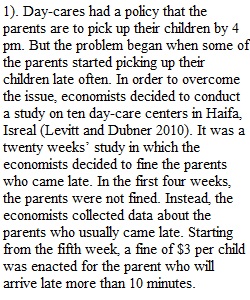


Q Assignment Directions Below you will find study guide questions from chapters 1 and 2 of Freakonomics. Your assignment is to answer 2 questions from each chapter (for a total of 4 questions) in a detailed paragraph for each question. Please include quotes and/or specific paraphrased materials for each of your answers. Your response should be a typed, MLA formatted document of at least 2 full pages. You can break this total down around the questions however you like. Study Guide Questions Chapter 1 Questions (choose 2 from this list) 1. Explain what happened with the day-care. Why didn't their plan to stop late pickups work? What might have fixed the problem? 2. Summarize the Conventional Wisdom that Levitt and Dubner were challenging about Sumo Wrestlers and school teachers. What do we believe about Sumo wrestlers and school teachers? 3. What incentives did sumo wrestlers and teachers have to cheat? What incentives did they have that discouraged them from cheating? 4. Explain what would happen if an economic incentive were used to encourage people to give blood instead of the moral/social incentives (t-shirt, stickers, good feeling that comes from saving a life) that are currently used. Chapter 2 Questions (choose 2 from this list) 1. What was the information asymmetry between the KKK and society? What information did they have that the rest of society did not, and how did that give them power? Finally, how did Stetson Kennedy balance out this asymmetry? 2. How do emotions like fear, insecurity, and sadness make information asymmetries worse? How do advertising companies prey on consumers using these kinds of emotional appeals? 3. So, to answer the question from chapter 2: How is the KKK like a group of Real Estate Agents? 4. How does the information about online dating disprove the conventional wisdom that a person is open to dating someone of any background (as they might put on their dating profile)? Assignment Guidelines In order to receive full credit, the assignment will accomplish all of the following: • Answer 4 questions total, 2 from each chapter • Use quotes and/or paraphrased information from the book to support your answer to each question • Submit answers in a typed MLA formatted document of at least 2 full pages Notes and things to keep in mind: • Typically, half a page of writing is plenty to answer each question, but some questions may need more detailed responses. you can answer each question with as little/much detail as needed, as long as you're answering it fully and hitting the 2-page mark. • It's common to be on the third page somewhere when you finish writing. Some students write 4 and 5(!) page study guides. This is definitely above-and-beyond work, and I welcome that level of work, but again, somewhere on the third page is usually plenty. • You do not need to include the questions with your response (and they will not count towards the overall 2-page minimum). • Numbering the questions is fine, but you should not indent the paragraphs. please keep the margins at 1" Sample Full-Credit Answer: Q: Why shouldn't you (always) trust a real estate agent who tells you to take an offer on a house you're selling? A: You shouldn't trust a real estate agent because they might be telling you what's best for them instead of what's best for you. While we think that real estate agents are supposedly there to help us sell our house and get the most money for it, Levitt and Dubner state in the text that they are only there to sell as many houses as possible, no matter the price. The agent makes a percentage commission on each sale. When discussing a house selling for $10,000 more than the original offer, the agent only makes $150 extra. Levitt and Dubner state that "if you earn $9,400 while she only earns $150, maybe your incentives aren't aligned at all" (Levitt and Dubner 7). The agent may not want to work longer for the extra $150 while you would be willing to wait for the extra $9,400. Rubric Assignment Rubric Assignment Rubric Criteria Ratings Pts This criterion is linked to a Learning OutcomeComplete The student meets all of the guidelines for the assignment as outlined on the assignment. 2 pts Complete The student meets all of the guidelines for the assignment as outlined on the assignment directions. 1 pts Incomplete The student missed at least some of the criteria or guidelines for the assignment. 0 pts Missing The student did not turn the assignment in before the deadline. 2 pts Total Points: 2 PreviousNext
View Related Questions